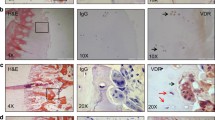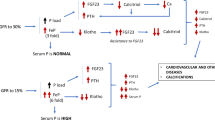Abstract
Vitamin D and FGF23 play a major role in calcium/phosphate balance. Vitamin D may control bone resorption but the potential role of FGF23 has never been evaluated. The objective of this study was therefore to compare the effects of vitamin D and FGF23 on osteoclast differentiation and activity in human monocyte-derived osteoclasts. Human monocytes, purified from blood of healthy donors, were incubated with M-CSF and RANKL to obtain mature multinucleated osteoclasts (MNC). Experiments were carried out to assess the effects of FGF23 as compared to native vitamin D (25-D) and active vitamin D (1,25-D) on osteoclast differentiation and on bone-resorbing osteoclast activity. Additional experiments with the pan fibroblast growth factor receptor inhibitor (FGFR-i) were performed. Phosphorylation Akt and Erk pathways were analyzed by Western blot analyses. Both 1,25-D and FGF23, to a lesser extent, significantly inhibited osteoclastogenesis at early stages; when adding FGFR-i, osteoclast formation was restored. Biochemical experiments showed an activation of the Akt and Erk pathways under FGF23 treatment. In contrast, in terms of activity, 1,25-D had no effect on resorption, whereas FGF23 slightly but significantly increased bone resorption; 25-D had no effects on either differentiation or on activity. These data show that 1,25-D inhibits osteoclastogenesis without regulating osteoclast-mediated bone resorption activity; FGF23 has biphasic effects on osteoclast physiology, inhibiting osteoclast formation while stimulating slightly osteoclast activity. These results may be of importance and taken into account in chronic kidney disease when therapies modulating FGF23 are available.





Similar content being viewed by others
References
Razzaque MS (2009) FGF23-mediated regulation of systemic phosphate homeostasis: is Klotho an essential player? Am J Physiol 296:470–476
Yamazaki Y, Tamada T, Kasai N et al (2008) Anti-FGF23 neutralizing antibodies show the physiological role and structural features of FGF23. J Bone Miner Res 23:1509–1518
Ben-Dov IZ, Galitzer H, Lavi-Moshayoff V et al (2007) The parathyroid is a target organ for FGF23 in rats. J Clin Invest 117:4003–4008
Yoshiko Y, Wang H, Minamizaki T et al (2007) Mineralized tissue cells are a principal source of FGF23. Bone 40:1565–1573
Faul C, Amaral AP, Oskouei B et al (2011) FGF23 induces left ventricular hypertrophy. J Clin Invest 121:4393–4408
Bacchetta J, Sea JL, Chun RF et al (2013) Fibroblast growth factor 23 inhibits extrarenal synthesis of 1,25-dihydroxyvitamin D in human monocytes. J Bone Miner Res 28:46–55
Gattineni J, Alphonse P, Zhang Q, Mathews N, Bates CM, Baum M (2014) Regulation of renal phosphate transport by FGF23 is mediated by FGFR1 and FGFR4. Am J Physiol 306:351–358
Kurosu H, Kuro-O M (2009) The Klotho gene family as a regulator of endocrine fibroblast growth factors. Mol Cell Endocrinol 299:72–78
Farrow EG, Davis SI, Summers LJ, White KE (2009) Initial FGF23-mediated signaling occurs in the distal convoluted tubule. J Am Soc Nephrol 20:955–960
Wang H, Yoshiko Y, Yamamoto R et al (2008) Overexpression of fibroblast growth factor 23 suppresses osteoblast differentiation and matrix mineralization in vitro. J Bone Miner Res 23:939–948
Sitara D, Kim S, Razzaque MS et al (2008) Genetic evidence of serum phosphate-independent functions of FGF-23 on bone. PLoS Genet 4:e1000154
Wesseling-Perry K, Pereira RC, Wang H et al (2009) Relationship between plasma fibroblast growth factor-23 concentration and bone mineralization in children with renal failure on peritoneal dialysis. J Clin Endocrinol Metab 94:511–517
Bonewald LF (2011) The amazing osteocyte. J Bone Miner Res 26:229–238
Cappariello A, Maurizi A, Veeriah V, Teti A (2014) The Great Beauty of the osteoclast. Arch Biochem Biophys 558:70–78
Takasu H, Sugita A, Uchiyama Y et al (2006) c-Fos protein as a target of anti-osteoclastogenic action of vitamin D, and synthesis of new analogs. J Clin Invest 116:528–535
Sakai S, Takaishi H, Matsuzaki K et al (2009) 1-Alpha, 25-dihydroxy vitamin D3 inhibits osteoclastogenesis through IFN-beta-dependent NFATc1 suppression. J Bone Miner Metab 27:643–652
Vincent C, Findlay DM, Welldon KJ et al (2009) Pro-inflammatory cytokines TNF-related weak inducer of apoptosis (TWEAK) and TNFalpha induce the mitogen-activated protein kinase (MAPK)-dependent expression of sclerostin in human osteoblasts. J Bone Miner Res 24:1434–1449
Kogawa M, Findlay DM, Anderson PH et al (2010) Osteoclastic metabolism of 25(OH)-vitamin D3: a potential mechanism for optimization of bone resorption. Endocrinology 151:4613–4625
Kogawa M, Anderson PH, Findlay DM, Morris HA, Atkins GJ (2010) The metabolism of 25-(OH)vitamin D3 by osteoclasts and their precursors regulates the differentiation of osteoclasts. J Steroid Biochem Mol Biol 121:277–280
Itonaga I, Sabokbar A, Neale SD, Athanasou NA (1999) 1,25-Dihydroxyvitamin D(3) and prostaglandin E(2) act directly on circulating human osteoclast precursors. Biochem Biophys Res Commun 264:590–595
Fugier-Vivier I, Servet-Delprat C, Rivailler P, Rissoan MC, Liu YJ, Rabourdin-Combe C (1997) Measles virus suppresses cell-mediated immunity by interfering with the survival and functions of dendritic and T cells. J Exp Med 186:813–823
Rivollier A, Mazzorana M, Tebib J et al (2004) Immature dendritic cell transdifferentiation into osteoclasts: a novel pathway sustained by the rheumatoid arthritis microenvironment. Blood 104:4029–4037
Harre U, Georgess D, Bang H et al (2012) Induction of osteoclastogenesis and bone loss by human autoantibodies against citrullinated vimentin. J Clin Invest 122:1791–1802
Bacchetta J, Salusky IB (2012) Evaluation of hypophosphatemia: lessons from patients with genetic disorders. Am J Kidney Dis 59:152–159
Hayashibara T, Hiraga T, Sugita A et al (2007) Regulation of osteoclast differentiation and function by phosphate: potential role of osteoclasts in the skeletal abnormalities in hypophosphatemic conditions. J Bone Miner Res 22:1743–1751
Hollberg K, Marsell R, Norgård M, Larsson T, Jonsson KB, Andersson G (2008) Osteoclast polarization is not required for degradation of bone matrix in rachitic FGF23 transgenic mice. Bone 42:1111–1121
Chen IP, Wang L, Jiang X, Aguila HL, Reichenberger EJ (2011) A Phe377del mutation in ANK leads to impaired osteoblastogenesis and osteoclastogenesis in a mouse model for craniometaphyseal dysplasia (CMD). Hum Mol Genet 20:948–961
Wang N, Robaye B, Gossiel F, Boeynaems JM, Gartland A (2014) The P2Y13 receptor regulates phosphate metabolism and FGF-23 secretion with effects on skeletal development. FASEB J 28:2249–2259
Hu L, Andersson G, Jonsson KB, Melhus H, Lind T (2013) Adamts1 is highly induced in rachitic bones of FGF23 transgenic mice and participates in degradation of non-mineralized bone matrix collagen. Biochem Biophys Res Commun 430:901–906
Gutiérrez OM, Mannstadt M, Isakova T et al (2008) Fibroblast growth factor 23 and mortality among patients undergoing hemodialysis. N Engl J Med 359:584–592
Wolf M, Molnar MZ, Amaral AP et al (2011) Elevated fibroblast growth factor 23 is a risk factor for kidney transplant loss and mortality. J Am Soc Nephrol 22:956–966
Pereira RC, Juppner H, Azucena-Serrano CE, Yadin O, Salusky IB, Wesseling-Perry K (2009) Patterns of FGF-23, DMP1, and MEPE expression in patients with chronic kidney disease. Bone 45:1161–1168
Shalhoub V, Shatzen EM, Ward SC et al (2012) FGF23 neutralization improves chronic kidney disease-associated hyperparathyroidism yet increases mortality. J Clin Invest 122:2543–2553
Acknowledgments
Lise Allard received an educational grant from the French Society of Pediatric Endocrinology and Diabetology for her master research project. A financial support was provided by Amgen, Sandoz and by la Fondation du Rein/Prix Jeune Chercheur 2013 (JB) for reagents and experiments. The authors would like to acknowledge Marlene Mazzorana, PhD, for her skillful technical help for the purification of monocytes and cell cultures.
Conflict of interest
Lise Allard, Nathalie Demoncheaux, Irma Machuca-Gayet, Dan Georgess, Fabienne Coury-Lucas, Pierre Jurdic and Justine Bacchetta declare that they have they have no conflict of interest.
Human and Animal Rights and Informed Consent
This article does not contain any studies with human participants or animals performed by any of the authors. Blood samples from healthy adult volunteer donors were purchased from the Etablissement Français du Sang, Site Gerland, Lyon, France.
Author information
Authors and Affiliations
Corresponding author
Rights and permissions
About this article
Cite this article
Allard, L., Demoncheaux, N., Machuca-Gayet, I. et al. Biphasic Effects of Vitamin D and FGF23 on Human Osteoclast Biology. Calcif Tissue Int 97, 69–79 (2015). https://doi.org/10.1007/s00223-015-0013-6
Received:
Accepted:
Published:
Issue Date:
DOI: https://doi.org/10.1007/s00223-015-0013-6




